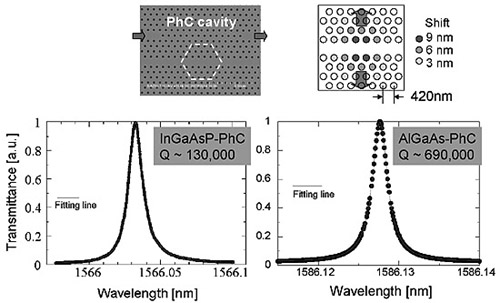Takehiko Tawara1, Kouta Tateno1, Tomonari Sato2, Takaaki Kakitsuka2, and Masaya Notomi1
1Optical Science Laboratory, 2NTT Photonics Laboratories
Photonic crystal (PhC) is a promising candidate as a platform to construct
devices with dimensions of several wavelengths. A PhC is an artificial
structure with light wavelength periodicity that can confine light in an
ultra small area of about 0.1 µm3 with an ultra high Q factor. We have been studying ways of strongly confining
light in ultra small areas with the aim of minimizing the light propagation
speed and enhancing the light-material interaction by using Si based PhCs.
In this report, we adopt new materials, namely InGaAsP and AlGaAsP, to
develop a new photonic technology. These materials have certain features
that Si does not have, e.g. they exhibit large refractive index modulation
owing to optical nonlinearity, and they are expected to be used for PhC
based active devices.
Figure 1 shows a scanning electron micrograph of an InGaAsP PhC and
transmission spectra of InGaAsP and AlGaAs PhC nanocavities. The PhCs are
composed of air holes arranged 420 nm apart in a triangular pattern and
they function as a light insulator at a wavelength of around 1.55 µm.
The area with no linearly arranged holes is the light waveguide and the
area where some holes are shifted few nanometers away from the center of
the waveguide functions as a cavity that can confine light [1]. InGaAsP
and AlGaAs PhC nanocavities have estimated Q factors of 130,000 and 690,000,
respectively. These values are around ten times larger than those previously
reported for PhC nanocavities with these materials. They are expected to
provide all-optical memories with very low operating power [2] and highly
efficient optical-mechanical power converters [3].
This work was supported by the National Institute of Information and
Communications Technology (NICT).
[1] E. Kuramochi, et al., Appl. Phys. Lett. 89 (2006) 241124.
[2] T. Tanabe, et al., Opt. Lett. 30 (2005) 2575.
[3] M. Notomi, et al., Phys. Rev. Lett. 97 (2006) 023903.
 |
||
|